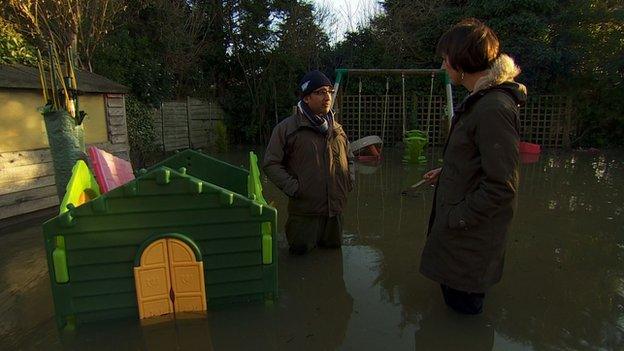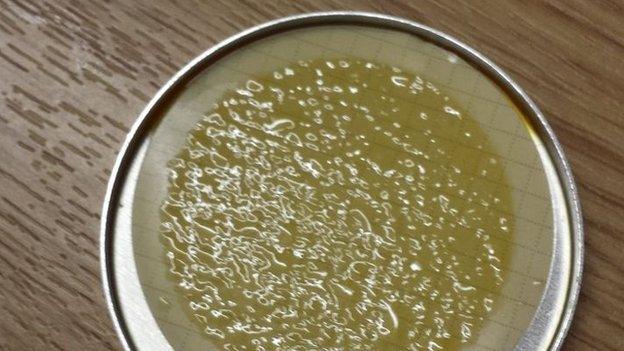UK storms: Living with contaminated flood water
- Published

Ham Sandhu's house in Wraysbury first flooded on 8 January
The water running thigh deep through Ham Sandhu's house in Wraysbury in Berkshire is freezing cold and murky.
Floating around in his kitchen is a toy car and a pair of slippers. Clunking gently together near the sink are two rubbish bins.
"I brought them in here," he says, "so they didn't drift away."
An unpleasant smell thickens the air.
"That must be the freezer," says Ham. "When we were flooded back on 8 January the insurance company told us not to empty it."
He doesn't want to look inside.

The flood water is just a couple of inches below the top of the bowl of his downstairs toilet.
Lance Weaver is from Delagua, a company that has developed a microbiological testing kit that has been used in disaster zones all over the world including the Philippines after Typhoon Haiyan struck.
Lance moves papers and bottles and other things Ham has lifted up onto the kitchen sideboard to save, to find a place for his small flight case.
The equipment inside this little suitcase provides a cosy, comfortable world for bacteria. The aim is to trap some in the flood water and feed them and encourage them to thrive.
Microbiologist Lance Weaver tests the water in a house in Datchet
Growing and counting colonies gives you an idea of what organisms might be in the water.
Lance prepares what will be their home for the next 16 hours. He drips pink fluid on to a thin white disc.
"This membrane looks like a make-up removal pad and I am soaking it in a membrane broth. This is a food which encourages the growth of certain types of bacteria and restricts the growth of other bacteria," he says.
He sterilises a metal cup by burning some ethanol in it, then bends down and dips it in the brown water. He then slots the cup in a kind of base unit and with his hand pumps the small black bulb attached to it.
"This manifold unit creates a vacuum that sucks bacteria on to the filter. They incubate for a period and grow in one spot so you can see them.
"The water has a cloudiness in it which will essentially block the filter - but we will run a series of experiments to dilute the water which eventually help us work out what the bacteria are," he says.

The result is a 'mega colony' of bacteria
When the result comes through, it shows that the water is heavily contaminated with faecal coliform. There are too many bacterial colonies to count.
Lance calls it a "mega colony". This suggests that the water is full of faecal matter.
"That is pretty bad," he says, pulling a face. "Pretty contaminated. If possible you do not want to go near it. And if you do, wash your hands."
I ask Ham how he feels about finding out what is swilling around in his kitchen.
"It is worrying. It is a bit of an eye opener. Hopefully when it is cleared out and sanitised it will be alright.
"My wife Mandy is going to have a busy time with the disinfectant," he says.